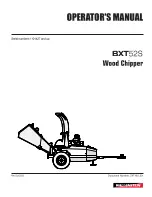
D-EIMWC00908-16EN - 28/52
Operation
Operator’s responsibilities
It is important that the operator is appropriately trained and becomes familiar with the system before operating the
machine. In addition to reading this manual, the operator must study the microprocessor operating manual and the wiring
diagram in order to understand start-up sequence, operation, shutdown sequence and operation of all the safety devices.
During the machine’s initial start-up phase, a technician authorized by the manufacturer is available to answer any
questions and to give instructions as to the correct operating procedures.
The operator is advised to keep a record of operating data for every installed machine. Another record should also be
kept of all the periodical maintenance and servicing activities.
If the operator notes abnormal or unusual operating conditions, he is advised to consult the technical service authorized
by the manufacturer.
Compressor Operation
The EEWD FZ compressors are two-stage. Suction gas enters the compressor through inlet guide vanes that can be
opened and closed to control refrigerant flow as the cooling load changes. The suction gas enters the first stage impeller,
is compressed, and travels through the vaned radial diffuser to the second stage impeller where compression is
completed. The gas travels to the condenser via the discharge volute, which converts any remaining velocity pressure to
static pressure.
Motor cooling is accomplished by utilizing the refrigerant effect of high-pressure liquid refrigerant from the condenser
expanded to a gas within the compressor. The refrigerant cools VFD heat sinks and the motor.
A five-axis magnetic bearing system supports the motor/compressor shaft, resisting radial and thrust forces. The bearing
control system uses shaft position feedback to continually adjust the bearing to keep the shaft in the correct position. In
the event of a power failure, the compressor motor acts as a generator and powers the bearing support system during
coastdown. There is also a system to gently de-levitate the shaft.
Many controls are mounted directly on the compressor where they monitor and control compressor operation. These
compressor controls are interfaced with the conventional MicroTech II controls to provide a complete chiller control
system.
System Water Volume
It is important to have adequate water volume in the system to provide an opportunity for the chiller to sense a load
change, adjust to the change, and stabilize. As the expected load change becomes more rapid, a greater water volume
is needed. The system water volume is the total amount of water in the evaporator, air handling products and associated
piping. If the water volume is too low, operational problems can occur including rapid compressor cycling, rapid loading
and unloading of compressors, erratic refrigerant flow in the chiller, improper motor cooling, shortened equipment life and
other undesirable consequences.
Some of the things the designer should consider when looking at water volume are the minimum cooling load, the
minimum chiller plant capacity during the low load period and the desired cycle time for the compressors.
Assuming that there are no sudden load changes and that the chiller plant has reasonable turndown, a rule of thumb of
“liters of water volume equal to 120 to 180 times the chilled water flow rate in liter/sec” is often used.
For process applications where the cooling load can change rapidly, additional system water volume is needed. A
process example would be a quenching tank. The load would be very stable until the hot material is immersed in the
water tank. Then, the load would increase drastically. For this type of application, system volume may need to be
increased.
Since there are many other factors that can influence performance, systems may successfully operate below these
suggestions. However, as the water volume decreases below these suggestions, the possibility of problems increases.
Variable Speed Pumping
Variable water flow involves inversely changing the water flow through the evaporator as the load changes. Cchillers are
designed for this duty provided that the rate of change in water flow is slow and the minimum and maximum flow rates for
the vessel, as shown in the vessel pressure drops figures, are not exceeded.
The recommended maximum change in water flow is 5% of the allowable flow change per minute. Flow is usually not
reduced below 50 percent of design flow (provided vessel minimum flow rates are not exceeded).
MicroTech II Control
Chillers are equipped with the MicroTech II control system consisting of:
Operator interface touchscreen panel with a 15-inch Super VGA color screen.
Control Panel containing the MicroTech II unit controller, two MicroTech II compressor controllers with connections to
the compressor-mounted controls, and various switches and field connection terminals.
Operating instructions for the MicroTech II controller are contained in Operating Manual.
Summary of Contents for C10FZXS
Page 16: ...D EIMWC00908 16EN 16 52 Figure 4 Evaporator pressure drop...
Page 17: ...D EIMWC00908 16EN 17 52...
Page 18: ...D EIMWC00908 16EN 18 52 Figure 5 Condenser pressure drop...
Page 34: ...D EIMWC00908 16EN 34 52 Figure 12 Compressor overview...
Page 50: ...D EIMWC00908 16EN 50 52...
Page 51: ...D EIMWC00908 16EN 51 52...
















































